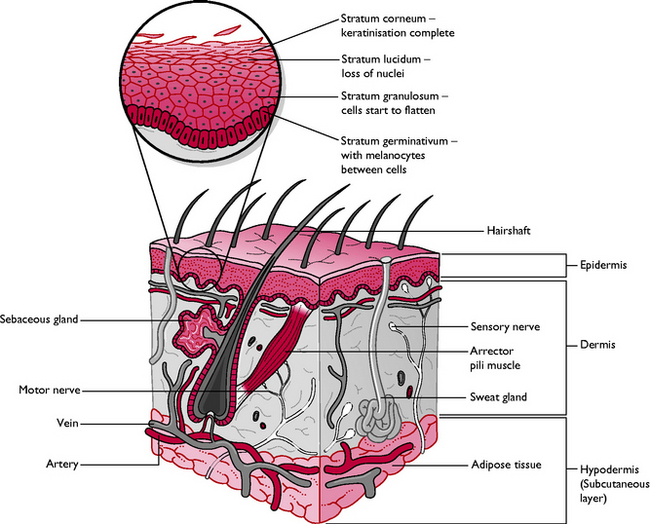Chapter 12 Common integument
• The common integument is the outer covering of the body and includes the skin, hair, pads and claws.
• The skin consists of two layers: the epidermis and dermis, under which is the hypodermis or subcuticular layer. This basic structure is also seen in footpads and claws.
• Within the skin are a range of glands, the secretions of which contribute to the overall function of the skin.
• The skin of the dog and cat is covered in hair, which is derived from epidermal cells. The function of hair is to protect, to insulate and to communicate.
• The underside of the foot is hairless and protected by the footpads, also derived from modified epidermis.
The skin
1 Protection – it protects the underlying structures of the body and, in specialised thickened regions of the skin, e.g. pads of the feet, it gives added protection against physical trauma. It also acts as a physical barrier to protect against invasion by microorganisms, and sebaceous glands secrete an antiseptic sebum on to the surface. The skin also acts as a waterproof barrier; it is almost impermeable to water, preventing the body from drying out or from becoming waterlogged, e.g. when swimming. Pigmented areas in the skin and hair protect against damage from ultraviolet radiation.
2 Sensory – the surface of the skin is well supplied with many types of sensory nerve ending to detect temperature, pressure, touch and pain. This assists the body in monitoring its external environment.
3 Secretion – a range of glands within the skin produce secretions directly on to the skin’s surface. These include sebum – produced by sebaceous glands; sweat – in the cat and dog sweating only occurs from active sweat glands of the footpads and nose; pheromones – produced by specialised skin glands.
4 Production – ultraviolet light from the sun converts 7-dihydrocholesterol present in sebum into vitamin D. This is activated within the kidney and liver and increases the uptake and metabolism of dietary calcium.
5 Storage – fat is stored under the skin as adipose tissue or subcutaneous fat. Fat is an energy store and also acts as a thermal insulating layer.
6 Thermoregulation – the skin prevents heat loss by diverting blood away from the surface by vasoconstriction, by erecting the hairs to trap a layer of insulating air, and by having an insulating layer of fat. Heat can be lost from the body when required, e.g. by the production of sweat. However, the skin only plays a minor role in heat loss in the dog and cat as they only have active sweat glands in their footpads and nose. Most of the dissipation of excessive body heat in dogs and cats occurs via panting.
7 Communication – production of pheromones, which are natural scents used for intraspecific communication. Other ‘scents’ produced for communication are those of the circumanal glands and glands of the anal sacs. The integument also provides a means of visual communication, e.g. a dog raises its hackles when threatened, which is seen as a warning of possible aggression.
Skin structure
The skin is composed of two layers: the epidermis or superficial layer and the underlying dermis (Fig. 12.1). The hypodermis lies beneath the skin.
Epidermis
The epidermis is composed of stratified squamous epithelium and has multiple layers of cells that are continually renewed. New cells are produced in the deepest layers of the epidermis and are pushed upwards to the surface as a result of mitosis below (see Ch. 1). The surface cells are continually lost and these dead cells or squames are seen as scurf in the animal’s coat. This process replaces the cells that are lost due to friction and wear. The layers, or strata, of the epidermis are, from deep to superficial:
1 Stratum basale or germinativum – consists of a single layer of dividing cells, i.e. where the new cells are ‘manufactured’. Pigmented cells or melanocytes, which contain granules of the pigment melanin, may also be present in areas such as the nose pad or footpad or in coloured areas of the body.
< div class='tao-gold-member'>
Only gold members can continue reading. Log In or Register to continue
Stay updated, free articles. Join our Telegram channel

Full access? Get Clinical Tree



